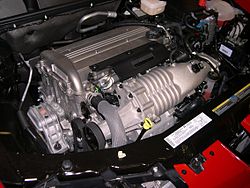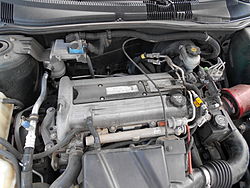Generation I
| Generation I | |
|---|---|
| Overview | |
| Production | 1999–2012 |
| Layout | |
| Displacement |
|
| Cylinder bore | 86 mm (3.4 in) |
| Piston stroke |
|
| Compression ratio |
|
| Combustion | |
| Fuel system | |
| Fuel type | |
| Dimensions | |
| Length | 665 mm (26.2 in) |
| Width | 642 mm (25.3 in) |
| Height | 655 mm (25.8 in) |
| Dry weight | 139–150 kg (306–331 lb) [1] |
The "Ecotec" name was adopted in 1994[ citation needed ] for the new generation of Family II engines (2000 in North America) . The name was already used for the Opel GM Family II engine, Family 1 and Family 0 ranges. GM intended this new Ecotec to become its global 4-cylinder, and it has already fully replaced their OHV I4 line.
The Ecotec engine is a DOHC 4-valve design with a lost foam cast aluminium block and head (L850 for 86 mm bore applications, and L880 for 88 mm bore[ citation needed ]), designed for displacements from 1.8 to 2.4 L. Development began in 1994, by an international team of engineers and technicians from Opel's International Technical Development Center in Rüsselsheim, Germany, GM Powertrain in Pontiac, Michigan, and Saab in Södertälje, Sweden. [2] Much of the development work on this project was carried out by Lotus Engineering, Hethel, United Kingdom. The engine uses aluminium pistons and cast iron cylinder liners. Vibration is reduced with twin balance shafts.
The first engine in the Ecotec Gen I line-up was Ecotec 2.2 L61, introduced in May 1999.
The current Ecotec line is manufactured in Tonawanda, New York. [2]
2.0
LK9

This engine is also known as B207 when used by Saab and Z20NET by Opel for use in the Vectra C and Signum.
LK9 is a turbocharged 2.0 L (1,998 cc) version of the L850 (86 mm bore) series Ecotec utilizing an all-new reinforced sand cast aluminium cylinder head and upgraded internal components. The engine features a five-bearing forged steel crankshaft, strengthened connecting rods, redesigned pistons, piston oil cooling jets, reprofiled camshafts and an integrated oil cooler. [3] The exhaust valves are liquid sodium-cooled. All vehicles using this engine feature Saab's Trionic 8 (T8) engine management system as well as a revised valve train. The timing chain and timing gears are also new, along with Saab's Direct Ignition system. The reinforcements, turbocharging, intercooling, internals, dual overhead camshaft, and such were developed by GM Powertrain Sweden (Saab Automobile Powertrain). It features an 86 mm (3.4 in) bore and stroke and a 9.5:1 compression ratio. Maximum power is 210 hp (160 kW) at 5300 rpm and 221 lb⋅ft (300 N⋅m) of torque at 2500 rpm. Maximum boost is 12.3 psi (0.85 bar).
Applications:
- 2003–2014 Saab 9-3 – B207E, B207L, B207R
- 2003–2008 Opel Vectra – Z20NET (rebadged B207L)
- 2003–2008 Opel Signum – Z20NET (rebadged B207L)
- 2006–2010 Cadillac BLS – B207L, B207R
| Model | Years | Power | Torque | Turbocharger | Boost Pressure |
|---|---|---|---|---|---|
| 1.8t (B207E) | 2003–2006 | 148 hp (110 kW) @ 5500 rpm | 177 lb⋅ft (240 N⋅m) @ 2000–3500 rpm |
| 7.3 psi (0.50 bar) |
| 1.8t (B207E) | 2006–2012 | 148 hp (110 kW) @ 5500 rpm | 177 lb⋅ft (240 N⋅m) @ 2000–3500 rpm |
| 7.3 psi (0.50 bar) |
| 2.0t (B207L) | 2003–2006 | 173 hp (129 kW) @ 5500 rpm | 195 lb⋅ft (265 N⋅m) @ 2500–4000 rpm |
| 8.7 psi (0.60 bar) |
| 2.0t (B207L) | 2006–2012 | 173 hp (129 kW) @ 5500 rpm | 195 lb⋅ft (265 N⋅m) @ 2500–4000 rpm |
| 8.7 psi (0.60 bar) |
| 2.0T (B207R) | 2003–2014 | 207 hp (154.5 kW) @ 5300 rpm | 221 lb⋅ft (300 N⋅m) @ 2500–4000 rpm |
| 12.3 psi (0.85 bar) |
LSJ

The LSJ is a supercharged version of the LK9 Ecotec 2.0 L (1,998 cc) with an Eaton M62 Roots-type supercharger and air-to-liquid intercooler. The LSJ shares many of its components with the LK9 such as: piston cooling jets, oil cooler, pistons, connecting rods, crankshaft, oil pan, sodium-filled exhaust valves and cylinder head. [4] It is rated at 205 hp (153 kW) at 5600 rpm and 200 lb⋅ft (271 N⋅m) at 4400 rpm with a compression ratio of 9.5:1 and a 6450 rpm redline. With the end of the Chevy Cobalt S/C SS and Saturn Ion Red Line, the LSJ was discontinued after 2007. In late 2005 Brammo Motorsports struck a deal with GM for the Supercharged 2.0 L Ecotec for their Ariel Atom. The engine came in various ratings from 205 hp (153 kW) to 300 hp (224 kW).
The LSJ was on the Ward's 10 Best Engines list for 2006.
This engine is used in:
| Year(s) | Model | Power | Torque |
|---|---|---|---|
| 2004–2007 | Saturn Ion Red Line | 205 hp (153 kW) @ 5600 rpm | 200 lb⋅ft (271 N⋅m) @ 4400 rpm |
| 2005–2007 | Chevrolet Cobalt SS Supercharged Coupe | 205 hp (153 kW) @ 5600 rpm | 200 lb⋅ft (271 N⋅m) @ 4400 rpm |
2.2
L61



The basic Family II architecture was substantially re-engineered in 2000 to become the Ecotec Gen I. Unlike its notably harsh predecessor, the engine was designed for smoothness. Dual in-block balance shafts were integral to the design, the power-steering pump was mounted directly to the cylinder head and driven by the intake camshaft, the water-pump housing was cast into the block, and the A/C compressor and alternator were mounted directly on the block without brackets. The oil filter housing was cast into the block with a removable cover and replaceable paper element. It did not use an EGR valve. The Ecotec line is manufactured in Tonawanda, New York, and Kaiserslautern, Germany, and was also manufactured for Saturn in Spring Hill, Tennessee, until Saturn's discontinuation. In North America, this engine replaced both the Quad-4 and the GM 122 engines and first appeared in the 2000 Saturn L-Series. [2]
The L61 is a 2.2 L (2,198 cc) version with a lost-foam cast aluminium cylinder head and block; it features an 86 mm (3.4 in) bore and 94.6 mm (3.72 in) stroke [2] and either a 9.5:1 compression ratio or a 10.0:1. The engine is 665 mm (26.2 in) in length, 642 mm (25.3 in) in width, 655 mm (25.8 in) in height and approximately 139 kg (306 lb). [2]
The Ecotec 2.2, model L61 first appeared in the 2000 Saturn LS1; the L61-powered Saturn Ion also replaced the Saturn-powered Saturn S-Series.
There are a few variations to the standard L61. The 2003 Saturn L-Series has a high output version with higher (10:1) compression and more aggressive camshaft. The 2004–2008 Chevrolet Malibu uses a version with electronic throttle control and a special unitized exhaust manifold and catalytic converter. The Malibu and Saturn versions also use return-less fuel injection. The 2002 Saturn VUE was the first North American variant of the L61 to be equipped with electronic throttle control, whereas other applications did not arise until 2005 in the Saturn ION and Chevrolet Cobalt. For 2007, introduced an updated version of the L61 based on the Gen II design.
The supercharger and inlet manifold from the 2.0 Ecotec LSJ engine can be purchased as an official kit from GM and along with modified software in the ECM, can create a 2.2 supercharged version of this engine.
The L61 was used in the following cars:
| Year(s) | Model | Power | Torque | Compression ratio |
|---|---|---|---|---|
| 2002 | Chevrolet Cavalier | 140 hp (104 kW) @ 5600 rpm | 150 lb⋅ft (203 N⋅m) @ 4400 rpm | 10.0:1 |
| 2003–2005 | 150 lb⋅ft (203 N⋅m) @ 4000 rpm | |||
| 2005–2006 | Chevrolet Cobalt | 145 hp (108 kW) @ 5600 rpm | 155 lb⋅ft (210 N⋅m) @ 4000 rpm | 10.0:1 |
| 2006 | Chevrolet HHR | 143 hp (107 kW) @ 5600 rpm | 150 lb⋅ft (203 N⋅m) @ 4000 rpm | 10.0:1 |
| 2004 | Chevrolet Malibu | 145 hp (108 kW) @ 5600 rpm | 155 lb⋅ft (210 N⋅m) @ 4000 rpm | 10.0:1 |
| 2005–2006 | 144 hp (107 kW) @ 5600 rpm | |||
| 2002–2004 | Oldsmobile Alero | 140 hp (104 kW) @ 5600 rpm | 150 lb⋅ft (203 N⋅m) @ 4000 rpm | 10.0:1 |
| 2002 | Pontiac Grand Am | 140 hp (104 kW) @ 5600 rpm | 150 lb⋅ft (203 N⋅m) @ 4400 rpm | 10.0:1 |
| 2003–2005 | 150 lb⋅ft (203 N⋅m) @ 4000 rpm | |||
| 2002 | Pontiac Sunfire | 140 hp (104 kW) @ 5600 rpm | 150 lb⋅ft (203 N⋅m) @ 4400 rpm | 10.0:1 |
| 2003–2005 | 150 lb⋅ft (203 N⋅m) @ 4000 rpm | |||
| 2005–2006 | Pontiac Pursuit/G5 | 145 hp (108 kW) @ 5600 rpm | 155 lb⋅ft (210 N⋅m) @ 4000 rpm | 10.0:1 |
| 2000 | Saturn L-Series | 137 hp (102 kW) @ 5800 rpm | 135 lb⋅ft (183 N⋅m) @ 4400 rpm | 9.5:1 |
| 2001–2003 | 135 hp (101 kW) @ 5200 rpm | 142 lb⋅ft (193 N⋅m) @ 4400 rpm | ||
| 2004 | 140 hp (104 kW) @ 5600 rpm | 150 lb⋅ft (203 N⋅m) @ 4000 rpm | ||
| 2003–2006 | Saturn Ion | 140 hp (104 kW) @ 5800 rpm | 145 lb⋅ft (197 N⋅m) @ 4400 rpm | 10.0:1 |
| 2002–2005 | Saturn Vue | 143 hp (107 kW) @ 5400 rpm | 152 lb⋅ft (206 N⋅m) @ 4000 rpm | 10.0:1 |
| 2006 | 143 hp (107 kW) @ 5600 rpm | |||
| 2007 | 144 hp (107 kW) @ 5600 rpm | |||
| 2001–2005 | Opel Speedster/Vauxhall VX220 [2] | 147 hp (110 kW) @ 5800 rpm | 150 lb⋅ft (203 N⋅m) @ 4000 rpm | |
| 2000–2003 | Opel/Vauxhall Astra [2] | 147 hp (110 kW) @ 5800 rpm | 150 lb⋅ft (203 N⋅m) @ 4000 rpm | |
| 2001–2002 | Opel/Vauxhall Vectra [2] | 147 hp (110 kW) @ 5800 rpm | 150 lb⋅ft (203 N⋅m) @ 4000 rpm | |
| 2000–2003 | Opel/Vauxhall Zafira [2] | 147 hp (110 kW) @ 5800 rpm | 150 lb⋅ft (203 N⋅m) @ 4000 rpm | |
| 2001–2006 | Holden Astra (TS) | 147 hp (110 kW) @ 5800 rpm | 150 lb⋅ft (203 N⋅m) @ 4000 rpm |
This engine also powered the Japanese-market Subaru Traviq, a badge-engineered Opel Zafira A. [5]
Following the GM–Fiat agreement, the 2.2 L engine is also used in:
- Fiat Croma unmodified
- Alfa Romeo 159 heavy modified with Gasoline direct injection
Z22YH
A direct injection version of the 2.2 L (2,198 cc) Ecotec features 153 hp (114 kW) of power at 5600 rpm and 162 lb⋅ft (220 N⋅m) of torque at 3800 rpm with a compression ratio of 12.0:1, and has been available in:
- 2003 Opel/Vauxhall Vectra
- 2003 Opel/Vauxhall Signum
- 2005 Opel/Vauxhall Zafira
- 2006–2009 Holden Astra (Australia and New Zealand only)
L42
The Ecotec 2.2, model L42 is a version of the Ecotec 2.2 designed to run on compressed natural gas (CNG). It delivers 129 hp (96 kW) and 129 lb⋅ft (175 N⋅m). It is used in the 2003–2004 Chevrolet Cavalier.


